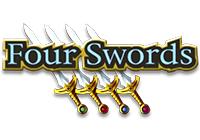The Legend of Zelda: Four Swords Anniversary Edition (Nintendo DS) Second Opinion Review
By David Lovato  08.03.2016
08.03.2016

Four Swords debuted as a multiplayer-only second game included with A Link to the Past for the Game Boy Advance. While anyone could watch the opening cinematic, those without at least one other GBA and copy of the game attached via link cable couldn't get further than the title screen. Enter the DSiWare port, released as a free download for Nintendo DS and 3DS.
The story begins abruptly (almost lazily) as Princess Zelda and Link check on the mysterious Four Sword, said to have sealed away the wind sorcerer Vaati. Zelda says she feels the seal weakening, and sure enough, Vaati appears and kidnaps the princess to make her his bride. Like all good video game villains, he inexplicably ignores Link and makes off with Zelda, leaving Link to grab the Four Sword that defeated him in the first place. The blade splits Link into four, and the adventure begins. The story isn't the most original or well-thought-out, but it does set things in motion and give good reasoning for the base mechanics of the game: Link is split into copies that must work together to defeat enemies and solve puzzles. Maps and puzzles themselves change depending on how many Links are present.

Added to the DS port is the ability to play alone. Players can pick a second Link, even choosing his colour, and, at the press of a button, can switch between the two. When performing tasks like pushing blocks or pulling apart enemies, the other Link will automatically appear and do his part. It's a big enhancement for a port - something we don't see out of Nintendo very often; like A Link to the Past before it, the game isn't simply emulated, but enhanced with new sounds, new mechanics, and the wise decision to allow for single-player gaming. Those playing with others via wireless will find incentives to work together, but also to compete, as rewards are doled out to the highest-performing Link.

Cubed3 Rating
Great - Silver Award

Somewhat simple in the story department, Four Swords shines when it comes to gameplay, and this Anniversary Edition is better in every way. Nintendo took the classic top-down Zelda format, applied the art style of The Wind Waker, and made a multiplayer game work in a series notorious for its single-player elements. There's incentive to work together and incentive to compete, the puzzles and enemies make use of the new mechanics, and everything Nintendo got wrong the first time (like leaving out single-player altogether) has been remedied. The final result is one of the quirkiest and most unique titles in the series.

![]() 8/10
8/10
![]() 8/10
(4 Votes)
8/10
(4 Votes)
 Out now
Out now  Out now
Out now  Out now
Out now  Out now
Out now Comments
Comments are currently disabled

 Sign In
Sign In Game Details
Game Details Subscribe to this topic
Subscribe to this topic Features
Features







 Top
Top

